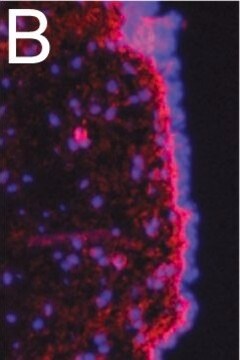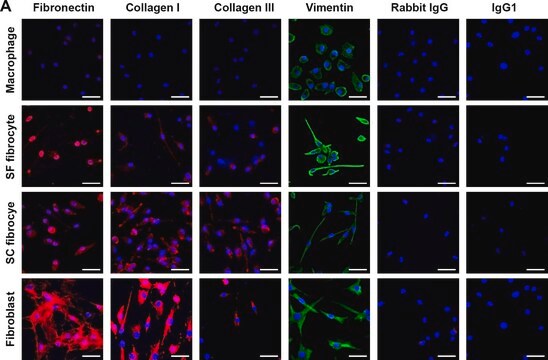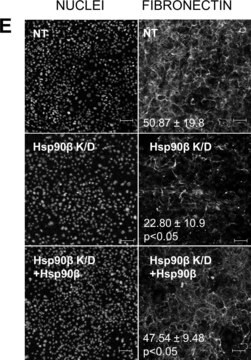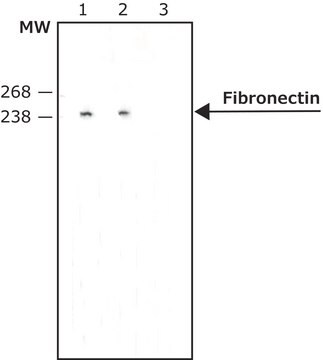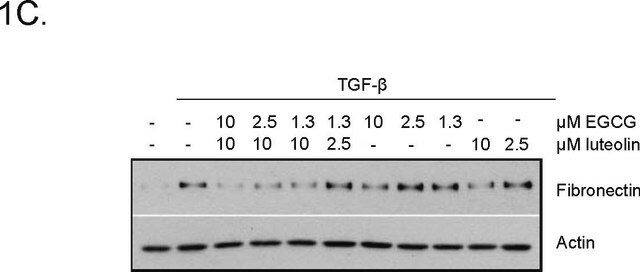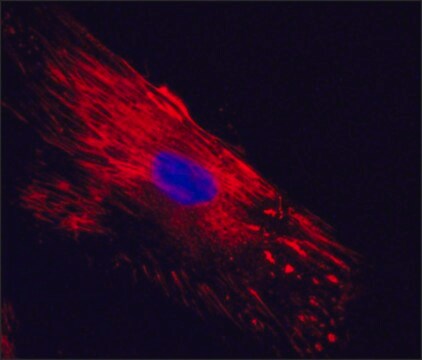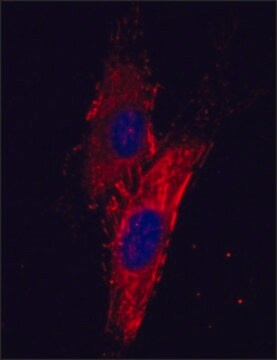AB2033
Anti-Fibronectin Antibody
CHEMICON®, rabbit polyclonal
Sinônimo(s):
Anti-CIG, Anti-ED-B, Anti-FINC, Anti-FN, Anti-FNZ, Anti-GFND, Anti-GFND2, Anti-LETS, Anti-MSF, Anti-SMDCF
About This Item
Produtos recomendados
Nome do produto
Anti-Fibronectin Antibody, Chemicon®, from rabbit
fonte biológica
rabbit
Nível de qualidade
forma do anticorpo
affinity purified immunoglobulin
tipo de produto de anticorpo
primary antibodies
clone
polyclonal
purificado por
affinity chromatography
reatividade de espécies
mouse
fabricante/nome comercial
Chemicon®
técnica(s)
ELISA: suitable
immunocytochemistry: suitable
immunohistochemistry: suitable
radioimmunoassay: suitable
nº de adesão NCBI
nº de adesão UniProt
Condições de expedição
dry ice
modificação pós-traducional do alvo
unmodified
Informações sobre genes
mouse ... Fn1(14268)
Descrição geral
Especificidade
Imunogênio
Aplicação
1:80 dilution of a previous lot was used in immunofluorescent staining of frozen mouse skin and liver tissues.
Radioimmunoassay:
A previous lot of this antibody was used in RIA.
ELISA:
A 1:200 dilution of a previous lot was used in ELISA.
Optimal working dilutions must be determined by the end user.
Cell Structure
ECM Proteins
Qualidade
Immunocytochemistry:
Representative image from a previous lot.
Confocal fluorescent analysis of NIH/3T3 using AB2033 rabbit polyclonal antibody (Red). Actin filaments have been labeled with AlexaFluor 488 -Phalloidin (Green). Nucleus is stained with DAPI (Blue).
forma física
Armazenamento e estabilidade
Nota de análise
Extracellular matrix in most tissue
Outras notas
Informações legais
Exoneração de responsabilidade
Não está encontrando o produto certo?
Experimente o nosso Ferramenta de seleção de produtos.
Código de classe de armazenamento
12 - Non Combustible Liquids
Classe de risco de água (WGK)
WGK 1
Ponto de fulgor (°F)
Not applicable
Ponto de fulgor (°C)
Not applicable
Certificados de análise (COA)
Busque Certificados de análise (COA) digitando o Número do Lote do produto. Os números de lote e remessa podem ser encontrados no rótulo de um produto após a palavra “Lot” ou “Batch”.
Já possui este produto?
Encontre a documentação dos produtos que você adquiriu recentemente na biblioteca de documentos.
Nossa equipe de cientistas tem experiência em todas as áreas de pesquisa, incluindo Life Sciences, ciência de materiais, síntese química, cromatografia, química analítica e muitas outras.
Entre em contato com a assistência técnica